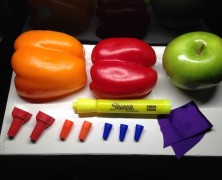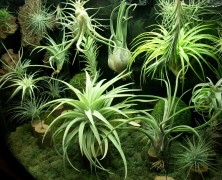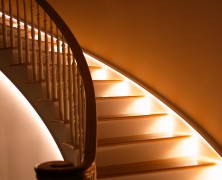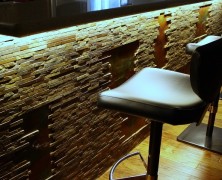CRI, or Color Rendering Index, is the latest buzzword in consumer lighting circles. With the current phasing out of traditional incandescent bulbs, many consumers are scrambling to understand their remaining choices. Savvy lighting manufacturers understand this, and have invested a great deal in educating customers about things like color temperature, lumens, and now CRI. So how does CRI work? Basically, take a light bulb and shine it onto a few bright, colorful items. How natural do their colors look? Color Rendering Index is a mathematical measure of this, where a light source is tested and given a score from 0-100. Any light bulb, tube, or strip that measures greater than 90 is typically considered “High CRI”, and thus very effective at rendering natural-looking color at a given color temperature. As a point of reference, many of the fluorescent or other types of lighting that people consider “harsh” or “artificial” measure in the 50-70 CRI range. Take a look at the two photos above. In the first photo, under lights rated at CRI 57, the orange bell pepper has lost much of its natural color, appearing almost yellow. Similarly, the green apple, red bell pepper, and yellow marker appear dull and lifeless. In the second photo, under CRI 93 lighting, the colors are much more alive in comparison, down to the white board on which everything is placed. Testing for CRI requires special machinery designed specifically for this purpose. During this test, a lamp is shone onto eight different colors (or “R values”), termed R1 through R8. The lamp receives a score from 0-100 for each color, based on how natural the color is rendered in comparison with how the color looks under a “perfect” or “reference” light source at the same color temperature...
Flexfire LEDs Announces High CRI LED Strip Lights...
posted by Flexfire LEDs
In keeping with its commitment to providing innovative LED lighting solutions, California-based Flexfire LEDs has announced its new UL Listed UltraBright™ High CRI Series LED Strip Lights. Designed to meet today’s higher lighting quality standards, this new line measures >93 on the color rendering index, fortifying the company’s reputation for delivering cutting edge technology at consumer-friendly prices. CRI, or color rendering index, is the standard measure of a luminaire’s ability to accurately render a specific color spectrum in comparison with a perfect reference source at a given color temperature (i.e. daylight). Simply put, if you direct the light onto a particular object, how natural do its colors look? Testing for CRI is a complicated process, requiring specialized machinery designed specifically for this purpose. Lamps are tested in terms of how they render eight basic colors (or “R values”), termed R1 through R8. A score from 0-100 is given for each color, and these eight numbers are then averaged to determine the lamp’s overall CRI rating. Those measuring above 90 are generally considered highly effective at rendering natural color; for a practical understanding, many of the traditional fluorescent lights that people consider “harsh” or “artificial” measure in the 60-70 CRI range. LED lighting is the established industry leader in energy efficiency, and advanced technological development means LED products are now available at dramatically lower prices than even just a few years ago. This dynamic is driving a worldwide shift to LED lighting, one that is further accelerated by government regulations such as those found in California’s Title 24. Established by the State’s Energy Commission, Title 24 addresses a number of energy efficiency standards, particularly those having to do with lighting. To be classified as “High Efficacy” and thus qualify for utility rebates and other advantages,...
How To Build Your Own Terrarium Grow Light Using LED Strip Lights...
posted by Flexfire LEDs
As both amateur and professional plant enthusiasts have discovered, energy-efficient LEDs are highly effective in virtually any grow light application. The benefits are immediately apparent: LED lights are long-lasting, use very little energy, and will not produce plant-wilting excess heat. As a result, many are installing LEDs in terrariums and other indoor garden applications. One of our customers did just that using UltraBright™ strip lights from Flexfire LEDs, and we asked him to share his experience in order to create a simple tutorial. Follow these steps and learn how to build your own terrarium grow light using LED strip lights. First, a combination of Flexfire LEDs 12v Design Series and 24v Architectural Series UltraBright™ strip lights were mounted onto aluminum bars and channels. This allows custom configuration, and the aluminum acts as a heat sink for the LEDs, helping them perform better and last longer. These aluminum bars are inexpensive and easy to find at any home improvement store. Adhesive pads were attached to the end of each bar; these pads rest on the rim of the terrarium. The power connection was soldered to the LED strip light, and a nylon tie was used to secure the power cables and protect the solder joints from any jarring movement. Finally, a blob of silicone was applied to insulate the solder points. The above process was repeated for the aluminum channels, also easily available at any home improvement store. Below left, a smaller aluminum channel was bolted onto two sides of the terrarium. Right, a view from below showing all the illuminated channels. Below left is a view from above one of the bars, which was painted black. The lights are on the underside, directed down at the plants. Also, a close-up...
LED Staircase Lighting...
posted by Flexfire LEDs
One of our customers created dramatic LED staircase lighting in his home using Warm White ColorBright™ strip lights from Flexfire LEDs. The strips were inserted into a routed channel along the staircase, and attached to a Honeywell programmable timer switch to enable automatic on/off at specific hours of the day. This installation adds aesthetic flair to staircases in both homes and commercial spaces, carrying increased safety benefits as well, particularly for the elderly and small children. In fact, according to a 2012 study published in Pediatrics magazine, a child under the age of 5 is admitted to U.S. emergency rooms every six minutes as a result of staircase accidents. Smart, safe, and great looking – a winning combo for your home or office! Choose one of our convenient Flexfire LEDs strip light kits to suit the appropriate brightness, length and color of your LED display case lighting project: ...
LED Strip Lights: Top 5 Concerns For Lighting Designers...
posted by Flexfire LEDs
LED strip lights deliver extreme versatility in a compact, low profile package. Their customizability is popular with creative lighting professionals everywhere, and this popularity promises to expand greatly as LED prices continue to fall. Obvious applications for flexible strip lights include above cabinet and under counter lighting, and the list continues to grow thanks to increased product development and innovation efforts. Here, therefore, is a quick checklist of the top 5 concerns for lighting designers to compare and choose among different LED strip light products. 1. Lumens Per ____? Every project is different, so determine what matters most before comparing overall lumen output. Lumens per watt, for instance, is most important for LEED and energy-efficient installations, while others may be more concerned with lumens per foot, meter, or reel. 2. CRI Customizable LED chips can be configured to produce a wide variety of lighting conditions. High quality LED strip lights are now capable of producing a color rendering index of 90 and above, rivaling the top lighting options found anywhere on the market today. 3. Certification Choose products that are UL or ETL Listed (U.S. and Europe, respectively), and provide the appropriate LM testing information from the Illuminating Engineering Society to certify claims regarding things like luminous intensity and CRI. 4. Dimming Capability Whether through a simple wall switch or smartphone mobile app, clients want the ability to adjust their lights using a dimmer. Professional grade LED strip lights should be compatible with desired dimming options. 5. Quality of Components LED chip design, heat sink, and PCB quality are among the factors that differentiate one LED strip light from another. These affect light quality, degradation and longevity, not to mention product safety. Look for a supplier who stands by his...










